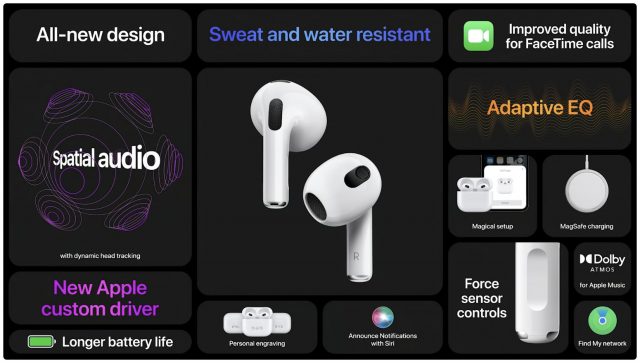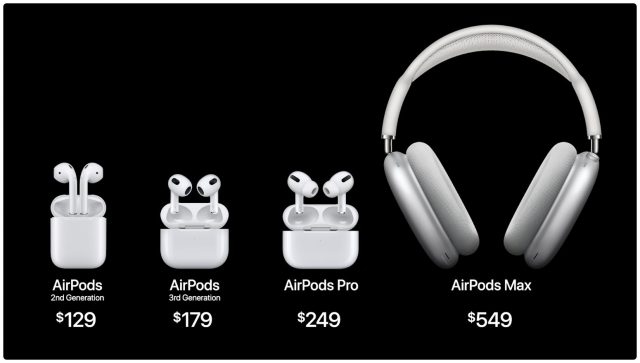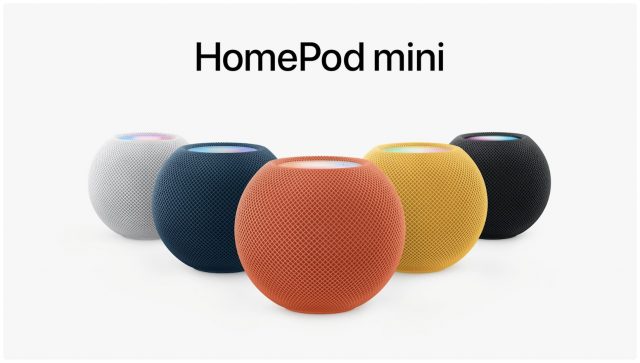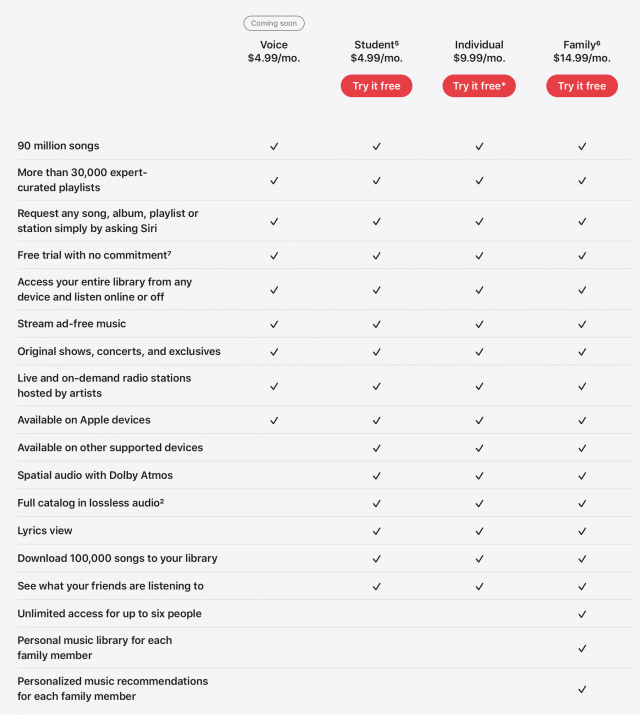Apple Unveils Third-Generation AirPods, Tweaks HomePod mini and Apple Music
New AirPods had been rumored for Apple’s “Unleashed” event, and that’s exactly what happened. But Apple expanded this initial portion of its presentation to focus more broadly on music, adding minor HomePod mini and Apple Music announcements.
Third-Generation AirPods
After releasing the AirPods Pro earbuds in October 2019 and the AirPods Max headphones in December 2020, Apple has turned its attention back to its humble, if insanely popular, AirPods, which last got an update in March 2019.
For the third-generation AirPods, Apple borrowed from the AirPods Pro design language. The new AirPods have shorter mic stalks and reshaped one-size-fits-all earpieces meant to be more comfortable than previous models. Their battery case is thus wider than the previous AirPods cases and similar to the AirPods Pro case.
The third-generation AirPods aren’t designed to accommodate silicone tips for ear canal sealing, like the AirPods Pro. However, ear tip providers are certain to find workarounds, as they have for the previous two AirPods generations.
These new AirPods incorporate a host of enhancements, some until now exclusive to higher-end AirPods models:
- Wireless charging with MagSafe: The AirPods Pro and second-generation AirPods can charge wirelessly on Qi-compatible pads. That’s also the case with the third-generation AirPods, but Apple has added MagSafe magnetic positioning when used with compatible MagSafe surfaces. (AirPods Pro purchasers will now also get MagSafe.)
- Updated dynamic driver: Apple says the new driver, powered by a custom amplifier, will offer everything from “deep, rich bass to crisp, clean highs.”
- Spatial audio: Found in the AirPods Pro and AirPods Max, spatial audio makes it seem like sound is coming from all directions, like in a movie theater. Plus, when paired with a compatible device, dynamic head tracking adjusts where the sound seems to be coming from as you move your head. For any of this to work, the audio must be in Dolby Atmos format, something Apple says is increasingly happening with new music.
- Adaptive EQ: Also found in the AirPods Pro and AirPods Max, adaptive EQ calibrates sound based on how the AirPods fit in the user’s ears.
- Sweat and water resistance: Those who exercise with their AirPods will appreciate the new IPX4 water resistance rating, which applies to both the earbuds and their battery case. Previously, only the AirPods Pro had sweat and water resistance.
- Force sensor: As with the AirPods Pro, the force sensor provides enhanced tactile control of music and calls.
The third-generation AirPods offer up to 6 hours of listening time on a single charge and up to 30 hours of total listening time with four recharges from the battery case. Five minutes of charging time yields an hour of listening time. These specs exceed those of both the AirPods Pro and the second-generation AirPods; get details in a chart I made in July to go with an audio-related article (see “The Ultimate Guide to Choosing Apple/Beats Audio Gear,” 19 July 2021).
Notable omissions in the third-generation AirPods are active noise cancellation and its related transparency mode, which seemingly remain reserved for the AirPods Pro and AirPods Max. That’s perhaps not surprising, given that they don’t fit into the ear canal or cover the entire ear.
The third-generation AirPods are priced at $179, with orders starting today in the United States and 26 other countries and regions. They’ll ship and be available in stores on 26 October 2021. The second-generation AirPods will remain available for $129, down from $159. An optional Qi-compatible charging case for the older AirPods remains a $79 separate purchase.
HomePod mini
Apple’s 4-inch HomePod mini speaker, the sibling to the larger and now-discontinued HomePod, was released in October 2020. Apple has now announced cosmetic enhancements.
The HomePod mini is now available in new and livelier colors—yellow, orange, and blue—to complement the original white and black (or space gray) options. This addition brings the HomePod mini in line with rival products, such as Amazon’s Echo Dot and Google’s Nest mini, which are available in multiple colors.
The HomePod mini remains priced at $99, with the new colors becoming available in November.
In a related and curious HomePod-related twist, Apple appears to have purged its site of any mention of its original and now-defunct speaker.
Apple Music Voice Plan
For those who often use the Siri voice assistant, Apple has built an Apple Music subscription tier accessible solely via spoken commands on Macs, iOS devices, and the HomePod mini, or when using CarPlay. It’s aimed at HomePod mini users who want an inexpensive alternative for a streaming music service. Nevertheless, it still provides access to the Apple Music catalog of 90 million songs, plus its playlists library, genre stations, and radio offerings.
Although signing up using the Music app is probably most comfortable, you can even subscribe to the Apple Music Voice Plan by saying, “Hey Siri, start my Apple Music Voice trial.” Once subscribed, you can make music requests on all of Apple’s Siri-enabled devices. Third-party integrations, such as Apple Music for Amazon Echo or Samsung Smart TVs (one of which I own), aren’t compatible with Apple Music Voice Plan.
Even though the Apple Music Voice Plan nominally works only via voice commands, users can still use the Music app. Apple says users will get a simplified app interface with suggestions based on their music preferences and a queue of music recently played via Siri. An app section called “Just Ask Siri” gives users tips on addressing the voice assistant for Apple Music use. Subscribers cannot download music to their libraries.
The Apple Music Voice Plan costs $4.99 a month and will be available later this year in the United States and 16 other countries and regions. A free trial will be available.
For access to Apple Music’s premium offerings, including full app access along with spatial audio, lossless audio, lyrics, music videos, and more, subscribers can switch to Apple Music’s Individual plan for $9.99 per month or its Family plan with up to six users for $14.99 per month.
Apple Music itself is getting minor improvements. Users will find hundreds of new mood and activity playlists that, Apple claims, “are fully optimized just for voice.” It’s hard to imagine these playlists being appropriate for a broad swath of users with radically different tastes in music.
Frankly, we found Apple’s highly abbreviated announcement of the Voice Plan difficult to parse and hard to understand, though more may become clear once it ships and can easily be compared to the existing plans. It may primarily be a way that Apple can introduce a less-expensive Apple Music plan to attract subscribers who may otherwise be happy with ad-supported listening on Spotify or YouTube.




Our original HomePods are paired and hooked up to our AppleTV 4K and the projector. Every movie we watch we love the audio. They really are great. But no return it seems despite the ‘Mini’ designation still attached to their current offering. We have a mini in the kitchen, wish it was orange now…
The Voice only plan seems designed for a bundle with them. Buy a Homepod Mini, get the voice only plan for a year. The smart playlists are fine but my version of a Seventies playlist for biking is not yours. I do enjoy curated playlists but generally for areas I don’t have expertise in, ambient or latin jazz, say. I can’t imagine not being able to craft my own for driving or biking.
I do wish they had released ways of sharing playlists more fully a la Spotify however.
I won’t be replacing the HomePod Mini I returned recently until it includes some version of the AirPod Adaptive EQ.